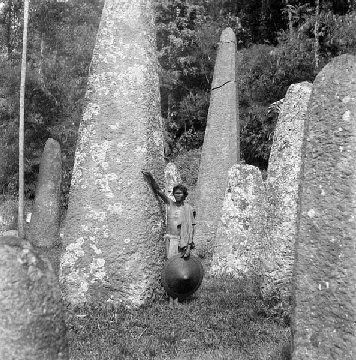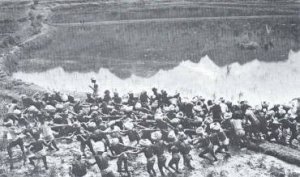|
 The Pacific Islands:
The Pacific Islands:
The Origin of the
Pacific Islanders:
The exemplary research by Thor Hyerdahll in the
1970's catapulted the field of prehistoric Polynesian migration into the
public eye. His 'maverick' approach to research has earned him a place
in the Hall-of-fame of modern explorers, anthropologist's and
historians alike. The debate over the origins of the Polynesian
Islanders is finally becoming clarified through genetic research, but
our understanding of the overall prehistoric Pacific people's way of
life, methods of oceanic navigation and cross-cultural exchanges is
still far from understood.
Maori
history from New Zealand describes their origin was from India, as we
see from the following extract from an article recorded from Maori
elders by Elsdon Best (1856 -1931 ) ;
'Maori tradition tells us that their ancestors in times long passed
away, 161 generations ago - (approximately 1500B.C. - a time of
turmoil in India), migrated from a hot country named Irihia (Vrihia
is an ancient name for India). The cause of exodus, from this
original homeland was a disastrous war with a dark-skinned folk, in
which great numbers were slain. The principle food supply on the
voyage was the sapless small seed named ari - the Indian word for
rice. They crossed the oceans (Indian Ocean and Atlantic), to
sojourn in two lands, named Tawhiti-roa (distant long land � Central
America) and Tawhiti-nui (distant big land - Peru - no voyage
between these two lands), after which they entered the isles of
Polynesia'.
This unlikely sounding Maori mythology has been recently
substantiated through genetic research.
Manfred Kaiser et al. found the male Y chromosome
(DYS390.3 deletion on the RPS4Y711T chromosome background) shared
by Polynesians and Melanesians, showed a divergence of genes 11,500
years ago, confirming a completely separate evolution of Polynesians
and Melanesians since this time. This very early date of separation
coincides with the time when rising sea level at the end of the last
Ice Age was flooding extensive coastal plains in S.E. Asia. Geneticist
Bing Su confirmed a separate evolution since this time of separation.
He found the major Melanesian Y-chromosome (haplotype H17,
characterized by mutations at M4, M5 and M9) was not found in
Polynesia." S.W. Serjeantson also confirmed a separate evolution. She
found that; the Human lymphocyte Antigens (HLA B13, B18 and B27)
are common amongst Melanesians but are totally absent from
Polynesians. A11 and B40 are significantly associated with each other
in Melanesia, whereas in Polynesian Populations, A11 is associated
with Bw48�. A11 is a Caucasian gene and appears to have been brought
into the Pacific on two separate occasions. Interestingly the only
other place in the world where HLA A11 is also found associated with
B40 is in the Indus region, once the home of the Harappa
civilization.
(1)
Article: ScienceDaily Jan. 2009
'Pacific People Spread from
Taiwan, Language Evolution, Study Shows'
'New research into language evolution
suggests most Pacific populations originated in Taiwan
around 5,200 years ago. Scientists at The University of
Auckland have used sophisticated computer analyses on
vocabulary from 400 Austronesian languages to uncover
how the Pacific was settled'.
(Link
to Full Article)
 Easter Island: Easter Island:
The art of Easter
Island has fascinated the world since its discovery in 1772. The cultural and
artistic similarities with pre-Columbian Peruvian cultures has led many
people to suggest a prehistoric contact between the two ancient cultures.
Easter Island is situated in the middle of the Pacific
Ocean, and was one of the primary islands of the Polynesian Island group.
It is best known for its hundreds of stone statues or 'Maoi' lie scattered around the island, and
which encircle it on long raised platforms.
The small, isolated nature of the island has led many
to suggest that this may have led to an implosion of tribal
activity on the island, which culminated only shortly before its discovery
by the Dutch.
( More about Easter Island)

The Yonaguni Nonument - Japan:
Although the recently discovered underwater structures
off the island of Taiwan were automatically rejected by scientists as a
natural feature, continued research is clearly pointing to a man-made
origin.
The
foundations of this structure reach down to a depth of 25m, which
according to current theories of sea-level rises, suggests an origin
date of around 10,000 years ago, coinciding with the end of the last
great Ice-age.
The
discovery of such an antiquated structure is no longer such an
unfeasible proposition following the discovery of the submerged city in
the Gulf of Cambay, off the Indian Coast in 2004.
(More
about Yonagumi and other Underwater Discoveries)
 Nan Madol
(Matol).
Ancient city built on a coral reef in the Caroline Islands. Nan Madol
(Matol).
Ancient city built on a coral reef in the Caroline Islands.
The megalithic stone
city of Nan modal was built with approximately 400,000 hexagonal,
crystalline, basalt blocks quarried and transported from the north side
of the island to the site. The site consists of 90 walled artificial
islands, divided by shallow canals. The ruined walls are still more than
125 ft high in places and up to 2,580 ft long. The blocks range from 12
to 27 ft in length, many weighing more than 10 tons. Other buildings can
be seen underwater that connect to the island. (12)
Excavations designed to reveal architectural building
stages and style changes verify more than 2000 years of occupation and
possibly a 1000 year span of major construction activity from A.D. 500
to 1500.
The highly stratified social system at Nan Madol
is the earliest known example of such centralized political power in the
western Pacific.
(More
about Nan Madol)
Indonesia:
Toraja Island.
 The
Toraja
area, in South Sulawesi, preserves around 100 menhirs, some of which
are huge, measuring 8 meters height. The ancient Torajanese erected
those stony monuments in front of the burial sites of important
people. The
Toraja
area, in South Sulawesi, preserves around 100 menhirs, some of which
are huge, measuring 8 meters height. The ancient Torajanese erected
those stony monuments in front of the burial sites of important
people.

The photo above was
taken by F. van der Kooi in 1937, showing a stone being dragged
through the paddy fields to its resting place.

Ha'amonga
'a Maui
(Burden of Maui) - is a 12-ton stone
trilithon located in
Tonga, Heketā, near the
village of
Niutōua, in the north of
the island of
Tongatapu, in the Pacific
ocean.
(More
about this Trilithon and Others)
|
List and Description of Featured Sites: |
(Pre-Columbian
Contact Between America and Pacific Cultures)
|
 Easter Island:
Easter Island: 

 The
T
The
T
